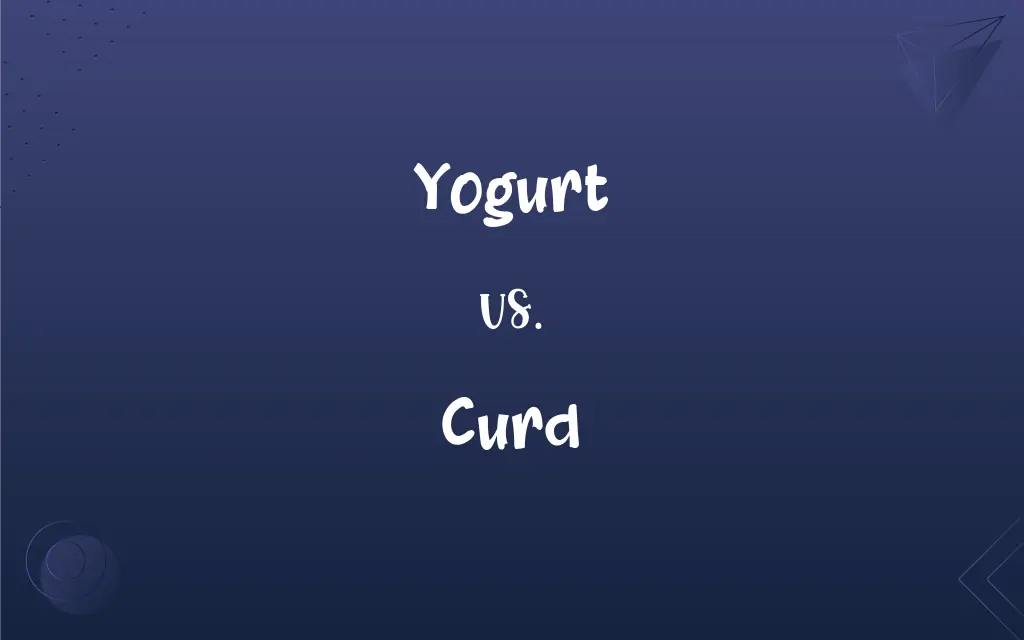Yogurt vs. Curd: What's the Difference?
Edited by Janet White || By Harlon Moss || Updated on October 19, 2023
Yogurt is a fermented dairy product made using specific bacterial strains, while curd is formed by the natural fermentation of milk using wild bacteria.

Key Differences
Yogurt and curd both originate from milk but undergo different fermentation processes. Yogurt is produced using specific bacterial strains, often Lactobacillus bulgaricus and Streptococcus thermophilus, which ensures consistency in taste and texture. Curd, on the other hand, forms by the natural fermentation of milk using wild bacteria present in the environment.
In terms of nutrition, yogurt often contains probiotics, which are beneficial bacteria that aid digestion and promote gut health. Curd, although rich in nutrients, might not always contain these probiotics due to the random bacterial strains involved in its formation.
Texture and taste differences between yogurt and curd arise from their distinct fermentation methods. Yogurt generally has a smooth and consistent texture, while curd's consistency can vary. The flavor of yogurt is also more standardized, while curd can taste different each time, depending on the bacteria involved.
Geographically, the preference for yogurt or curd varies. In the U.S., the term "yogurt" is more prevalent, and the product is often flavored and sweetened. In contrast, in many parts of India, "curd" is a household staple and is used in various dishes.
Comparison Chart
Fermentation Agent
Specific bacterial strains.
Wild bacteria from the environment.
ADVERTISEMENT
Consistency
Generally smooth and consistent.
Can vary based on bacterial strains and conditions.
Taste
Standardized taste.
Taste can differ each time.
Probiotic Content
Often contains probiotics.
Might not always have probiotics.
Geographical Use
More prevalent term in the U.S.
Commonly used term in parts of India and some other countries.
Yogurt and Curd Definitions
Yogurt
Consumed globally in various forms like Greek yogurt, frozen yogurt, and drinkable yogurt.
While traveling, they tried a local version of yogurt in each country.
ADVERTISEMENT
Curd
A common dairy product in many Asian cuisines.
Curd rice is a popular dish in southern India.
Yogurt
Often flavored or sweetened in commercial varieties.
Vanilla yogurt is her favorite snack.
Curd
The consistency and taste can vary based on fermentation conditions.
The curd today tasted slightly tangier than usual.
Yogurt
A fermented dairy product made with specific bacteria.
She enjoys having Greek yogurt for breakfast.
Curd
A product of milk fermentation through natural bacteria.
She sets the milk aside to make curd for tomorrow.
Yogurt
Typically thicker and creamier than milk.
The yogurt in this recipe gives it a creamy texture.
Curd
Can be used to make dishes or consumed directly.
He uses curd as a marinade for his chicken.
Yogurt
A source of probiotics beneficial for digestion.
Doctors recommend eating yogurt to maintain gut health.
Curd
Sometimes used as a base for making other dairy products.
She used the curd as a starter for making cheese.
Yogurt
A custardlike food with a tart flavor, prepared from milk curdled by bacteria, especially Lactobacillus bulgaricus and Streptococcus thermophilus, and often sweetened or flavored.
Curd
The part of milk that coagulates when the milk sours or is treated with enzymes. Curd is used to make cheese.
Yogurt
A milk-based product stiffened by a bacterium-aided curdling process, and sometimes mixed with fruit or other flavoring.
Yogurt
Any similar product based on other substances (e.g. soy yogurt).
Yogurt
A custard-like food made from curdled milk
FAQs
Does yogurt always contain probiotics?
Many yogurts contain probiotics, but it's best to check the label for confirmation.
What is yogurt made from?
Yogurt is made from milk fermented by specific bacterial strains.
Are there non-dairy versions of yogurt?
Yes, there are non-dairy yogurts made from soy, almond, coconut, and other alternatives.
Why is my curd sometimes runny and sometimes thick?
Curd's consistency can vary based on bacterial strains and fermentation conditions.
Why is yogurt sometimes sweetened in stores?
In the U.S., sweetened and flavored yogurt varieties are popular as snacks or desserts.
Can I make curd without adding any external agents?
Yes, curd can form naturally from the bacteria present in the environment and milk.
Can I use curd as a base for desserts?
Yes, curd can be used in various desserts and dishes.
Is it safe to eat curd daily?
Generally, yes, consuming curd daily can be a good source of calcium and other nutrients.
Can I use yogurt in place of curd in recipes?
Generally, yes, but the taste and texture might slightly differ.
Can I make yogurt at home?
Yes, by fermenting milk with a yogurt starter containing specific bacteria.
Which has more fat, yogurt or curd?
It depends on the type of milk used. Both can be made from full-fat or low-fat milk.
Is curd always sour?
Curd's taste can range from mild to sour, depending on fermentation duration and conditions.
Are there any health benefits to eating yogurt?
Yes, yogurt is rich in protein, calcium, vitamins, and often contains probiotics beneficial for gut health.
Why is Greek yogurt thicker than regular yogurt?
Greek yogurt is strained to remove whey, resulting in a thicker consistency.
Can I use yogurt in cooking?
Yes, yogurt is often used in cooking, but it's best added at lower temperatures to prevent curdling.
Is curd the same as yogurt?
No, while both are fermented milk products, yogurt uses specific bacteria, and curd forms from natural fermentation.
Does yogurt have an expiration date?
Yes, store-bought yogurt has an expiration date, but it might last a few days beyond if stored properly.
Which is better for digestion, yogurt or curd?
Both are good, but yogurt often contains probiotics known to aid digestion.
Is curd used in any specific cuisines?
Curd is a staple in many Asian cuisines, especially in Indian dishes.
How is curd different from cottage cheese?
While both originate from milk, curd is a fermented product, whereas cottage cheese is made by curdling milk.
About Author
Written by
Harlon MossHarlon is a seasoned quality moderator and accomplished content writer for Difference Wiki. An alumnus of the prestigious University of California, he earned his degree in Computer Science. Leveraging his academic background, Harlon brings a meticulous and informed perspective to his work, ensuring content accuracy and excellence.
Edited by
Janet WhiteJanet White has been an esteemed writer and blogger for Difference Wiki. Holding a Master's degree in Science and Medical Journalism from the prestigious Boston University, she has consistently demonstrated her expertise and passion for her field. When she's not immersed in her work, Janet relishes her time exercising, delving into a good book, and cherishing moments with friends and family.































































